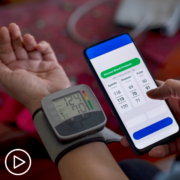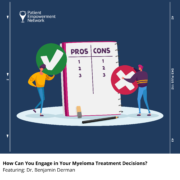Understanding Possible Side Effects of CAR T-Cell Therapy
Understanding Possible Side Effects of CAR T-Cell Therapy from Patient Empowerment Network on Vimeo.
What side effects should you be aware of when considering CAR T-cell therapy? Dr. Adriana reviews the issues that may occur after undergoing CAR T-cell therapy and how the side effects are managed.
Dr. Adriana Rossi is co-director of the CAR T and stem cell transplant program at the Center for Excellence for Multiple Myeloma at Mount Sinai Health System in New York City. Learn more about Dr. Rossi.
See More From Thrive CAR T-Cell Therapy
Related Resources:

|

|

|
Transcript:
Katherine Banwell:
Of course, we know that CAR T-cell therapy comes with some potential side effects. Let’s talk about some of those side effects and how they’re managed. You mentioned cytokine release syndrome earlier. Let’s start with that. What is it, exactly?
Dr. Adriana Rossi:
As I mentioned, cytokines are molecules that the cells of the immune system use to communicate with each other. With this therapy, we are asking the T cells that have been infused to expand, meaning make multiple copies of themselves, and sweep through the body looking for myeloma and basically picking a fight with them.
So, CRS is what happens when the T cells are too good at their job and they overachieve and then picking a little fight kind of make a big ruckus. The result is what we call inflammation, which the patient will experience usually as a fever.
But if it does not go – if it continues to go unchecked, that fever can be accompanied by low blood pressure because of these inflammatory markers, difficulty breathing or low oxygen levels. And all of these things are now vastly prevented. CRS is usually treated very quickly and doesn’t get to these higher grades, more complicated fields.
Katherine Banwell:
How is CRS managed?
Dr. Adriana Rossi:
We have a couple of very good antidotes. CRS by itself is not just a fever. Certainly, a fever in any patient who is undergoing these kinds of therapies, we will try to rule out any infections. But there are markers in the blood that we can follow. When the blood markers and the fever occur at the same time, we know that cytokines are driving that effect. If it seems to be driven by something we call IL-6, we use tocilizumab (Actemra). If it seems to be driven by IL-1, we use anakinra (Kineret). These are all drugs that are themselves monoclonal antibodies which then will shut down that overreaction and cool things down.
Katherine Banwell:
Another possible side effect is neurotoxicity. Would you define that term for us?
Dr. Adriana Rossi:
Yes. That one is harder to define because neurotoxicity in itself is very broad. We usually think of something called ICANS, which is the neurotoxicity associated with the effector cells. That specific neurotoxicity tends to happen in conjunction with CRS.
And while CRS probably occurs in about 85 percent of patients, the ICANS is usually in the order of 5 percent. So, much, much more rare. And the antidote for that, which most patients know, love, and hate, is steroids.
Katherine Banwell:
Ah, yes.
Dr. Adriana Rossi:
I should mention there are other parts of neurotoxicity which I think the most concerning is something that has been known as Parkinsonian symptoms. It’s really just movement disorder. These are exceedingly rare and so we haven’t had a chance to learn very much because there are so few patients who have had this complication. We have learned from the first six patients who had this how to avoid it. And so, I think it’s now even more rare and it really goes into patient selection, to making sure, as I mentioned, that the myeloma isn’t growing very much.
We monitor to see if the T cells grow too fast, if the CRS is of a high level. These are all predictors of delayed neurotoxicity.
Katherine Banwell:
What are the signs of neurotoxicity in a patient?
Dr. Adriana Rossi:
Very specifically, for the ICANS, we have tool called the ICE tool, which is a series of questions to test memory and attention and ability to write and understand and speak. So, most commonly, it would be an inability to speak properly or, if someone is writing a sentence, it’s really a very classic finding. It is no longer spread across the page.
These are not subtle findings. Part of, again, being in the hospital is to allow us to have this tool twice a day and look for these signs very early on, interfere with their development by giving the patients steroids – usually for a day or two – and resolving it.
Katherine Banwell:
And is there a potential for long-term issues associated with neurotoxicity?
Dr. Adriana Rossi:
Certainly, there is always the potential. But the vast majority – again, the ICANS tend to be self-limited while the patient’s in the hospital, and that is why we’re watching during that window. The delayed neurotoxicities, in addition to these very rare movement disorders, we do see some cranial nerve palsies. The seventh cranial nerve, usually recognized as Bell’s palsy, has happened a few times. We really don’t understand the mechanism of what is driving it. It’s inflammation but why there, why that way. So, we tend to use acyclovir, which is the classic treatment for Bell’s palsy and steroids.
Katherine Banwell:
Dr. Rossi, a suppressed immune system is something that a patient undergoing CAR T-cell therapy should consider. What does it mean, and what precautions should patients take?
Dr. Adriana Rossi:
That is such a good question, and it is specifically true for patients who are receiving therapies that target BCMA, which both commercial CAR Ts at the moment target.
Because it is such an effective therapy at bringing down cells that express BCMA, your immune cells that make antibodies, one of the side effects is the immunoglobulins, which are the antibodies, are all very, very low. So, that is one level of immunosuppression.
The other is the chemotherapy that we use to quiet the T cells can also lower all the blood counts. So, red blood cells and platelets may be low as well and those are not involved with immunity and can be transfused. So, that is a supportive mechanism. For the immune therapies, we usually use IVIG, which is intravenous immunoglobulins to support the patient until they’re able to make their own.
We also protect them from viral infections with acyclovir or valacyclovir. Protect them from something called PJP pneumonia, which is a virus that specifically appears when you’re very immunosuppressed. Should their neutrophil count be low, that is another type of white blood cell – make sure they’re protected with antibiotics.










